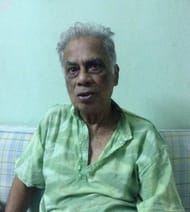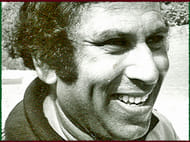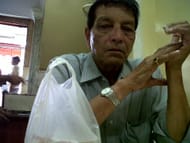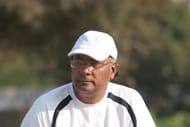Syed Abdul Rahim
The fulcrum of my knowledge about SA Rahim is based on my multiple interactions with his famous students Chuni Goswami, Balaram, PK Banerjee, Peter Thangaraj, Yousuf Khan, Syed Nayeemuddin and many more. Besides them, incisive discussions with his son, SS Hakim, also helped me to understand Rahim’s vision and why he is hailed as one of India’s greatest coaches.
My prized possession is a book which was authored by him. It contains couplets based on football. He made use of his urdu poetry to explain the basics of the game to his wards. I strongly feel that he must have been a talented person. He was a physical education teacher, referee, administrator and poet. All these traits in him helped shape careers of the Indian football luminaries.
A day before the final of the 1962 Asian Games football final at Jakarta, Rahim spent his night at the gallery, smoked and dreamt of making India champions against the hostile fans. He was a cancer patient and knew he had only a few years left in his life. But his attitude was like har fikr ko dhuen mein udata chala…
Rahim was born on August 17, 1909. He was the greatest player of Hyderabad from the 1920s to the early forties.
Rahim became famous first with the legendary Hyderabad Police team and later with the Indian team, with whom he won the 1951 and 1962 Asian Games gold. Besides, who can forget India’s stupendous performance in the 1956 Melbourne Olympics, where they finished fourth.
He had an excellent understanding of the game. Besides, he had some exceptionally skillful players; many of them were from Hyderabad and he was therefore familiar with their abilities.
Rahim retired as the principal of a high school in Hyderabad, and had been associated with the game till his death on June 11, 1963.
Amal Dutta
He is the Euclid of Indian football. I haven’t seen anyone so learned in the game. Amal da stood ahead of the rest due to his bold vision and multiple theories. He is unmatched and a tireless coach, who wouldn’t mind doing ample research on the teams, matches, technique and formations. No wonder he has been credited with creating lot of variations with teams he had coached during his illustrious career. Another thing that I admire in him is he loves to teach budding players. He will be the last coach who will prefer to coach a star-studded team. He loved to produce talented players and because of this, he is still revered by his students.
A competent midfielder with East Bengal in the 1950s, he represented India in the 1954 Asian Games at Manila. After his playing career was over, he went to England for a one-year FA coaching course, where he was taught by the renowned Walter Winterbottom.
Dutta still remains one of the few refreshingly innovative coaches in Indian football, famed for his tactical innovations. A fine thinker of the game, he broke a Bengali middle-class dream of a secure Government job when he quit Indian Railways to become a full-time coach in the 60s.
PK Banerjee
One of SA Rahim’s few famous protege who also became equally successful as a coach with both East Bengal and Mohun Bagan in the 70s and 80s.
Through his words, Pradipda has always been a non-stop entertainer. I didn’t come across a single player who hated or disliked him. Many called him as a motormouth coach who also was famous for his pep talks. Probably, he only knew how to handle the tantrums of star players when he coached Bagan and East Bengal.
Most critics say Pradip da was extremely lucky to have a generation of extremely talented and skillful players during his time. But I feel, as a coach, his PR skills was excellent. He was smart enough to tackle his star-studded teams. While he played under Rahim, Pradip da may have observed the master tactician. In fact, he borrowed a few of his ideas and wonderfully mixed them with his own knowledge and tactical acumen to bring unprecedented success to both his clubs and the Indian national team.
Syed Nayeemuddin
I would call him as Indian football’s only socialist coach. Nayeem is introverted and rarely expressed his emotions. But after knowing him for all these years and his success with East Bengal and Mohun Bagan in early 90s, I must say he knew his job well.
Like Pradip da, he too was inspired by SA Rahim during his stint as a Hyderabad Police player. Old-timers say that he was one of India’s best defenders who rarely committed a foul on an opponent player. After retiring as a player, Nayeem has been an honest coach, who really cared for the players. He often explained why good food and nutrition is important for Indian players who mostly came from poor families.
Nayeem’s fabulous success with Bagan and East Bengal came at a time when both these clubs were struggling. His understanding of the game, players and his knowledge led him to a plethora of trophies.
Armando Colaco
He was one of the first few club coaches in India who broke the hegemony of Calcutta teams. Armando is credited with building a Dempo team which suddenly became undisputed champions in domestic football. Colaco became the first I-League manager to guide an Indian club to the AFC Cup semifinals in 2008. After joining Dempo in 2000, Colaco understood the strength of keeping same group of players under one roof.
Without making any big changes in the team, he maintained an excellent coordinated unit. This is one of the reasons why he was so successful with an institutional team which gave hard times to both Mohun Bagan and East Bengal and ended their domination to a large extent. Colaco’s success with Dempo became a role model for other Goan teams. He wasn’t a rigid coach, who, however, preferred to have local Goan players in his team rather having outstation players in a Goan club.
Today, his logic is now backed by the stupendous success he enjoyed during his 13-year stint as Dempo’s and India’s one of most successful coaches.
Subhash Bhowmick
Nicknamed Bhombolda, Bhowmick earned fame with East Bengal in 2003 when he won the National League and ASEAN Cup in Jakarta. With some good, talented players in the team, Bhowmick dreamt of success. He made the club understand the relevance of modern football’s basic needs like gym and outstation camps.
Like Armando Colaco, he too wanted to have all his players under one roof. Hence, the team ventured out in the suburbs of Calcutta, far from the media gaze. He started to give reference about Manchester United and Alex Ferguson’s success. At the club lawn, Bhowmick initiated some changes. He stopped players from speaking to journalists on the ground, which he felt, was done to protect them. Besides, he would have his post-training media briefings only in scheduled times.
Bhowmick later proved that the changes were done to professionalise the set-up when he won the international event, ASEAN Cup, where East Bengal beat some of the top south-Asian clubs.
But he couldn’t produce the same results with other teams like Mohammedan Sporting (2006) and Salgaocar. Only last season, as the Technical Director, Bhowmick led Churchill Brothers to I-League victory.





